Why Hard Scape Elements Are the Foundation of Great Outdoor Spaces
Hard scape refers to the non-living elements of landscape design – including patios, walkways, retaining walls, fire pits, and driveways – that provide structure and functionality to your outdoor space. Here are the essential hard scape elements every homeowner should know:
- Patios and decks – Foundation spaces for outdoor living and entertaining
- Walkways and paths – Guide movement and connect different areas
- Retaining walls – Manage slopes and create defined planting areas
- Fire features – Extend outdoor season and create gathering spots
- Water features – Add ambiance with fountains or ponds
- Outdoor kitchens – Bring cooking and dining outdoors
- Steps and edging – Provide safety and clean transitions
According to the American Society of Landscape Architects, professional hardscaping can add up to 15% to your home’s value. Unlike softscape elements (plants, grass, flowers), hard scape features provide year-round structure and require minimal maintenance once properly installed.
The term “hardscape” first appeared in 1972, distinguishing these permanent installations from traditional landscaping. Today’s hardscape materials range from classic flagstone and brick to modern permeable pavers that can reduce stormwater runoff by up to 100%.
The key difference: hardscape creates the “bones” of your outdoor design, while softscape adds the living beauty that changes with seasons.
I’m Pete Marsh, founder of Blue Oak Patio and Landscape, and I’ve spent over two decades helping Hilliard homeowners transform their yards with custom hard scape solutions. My team and I specialize in creating durable outdoor spaces that blend functionality with lasting beauty.
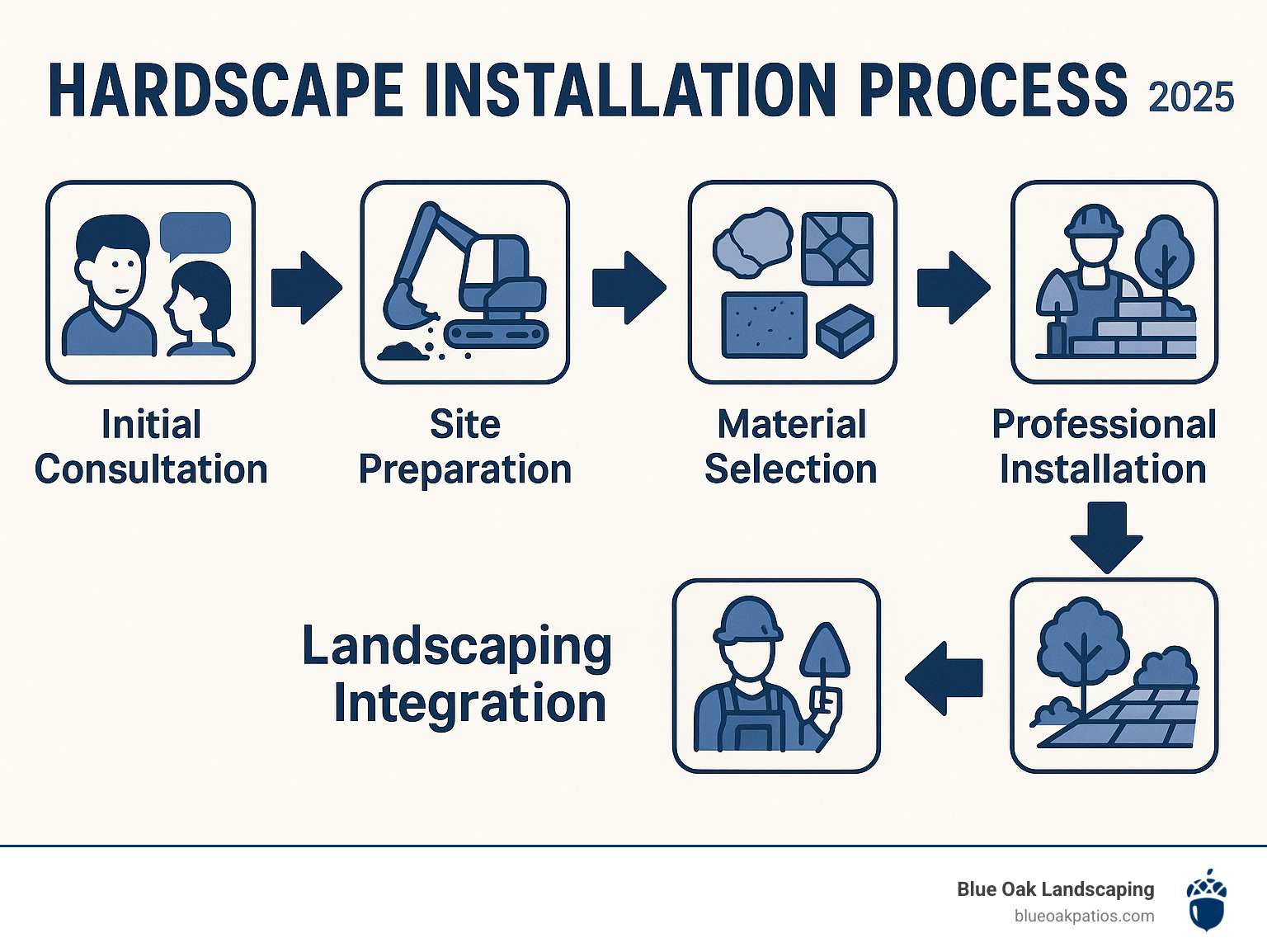
Understanding Hard Scape vs. Landscape
Picture your outdoor space as a stage production. Hard scape elements are like the set pieces – the permanent structures that define the space and stay put through every season. These include your patios, walkways, retaining walls, and fire pits. Landscape (or softscape) is like the actors – the living plants, flowers, and trees that bring movement, color, and seasonal drama to the scene.
Hard scape forms the backbone of any great outdoor design. These non-living materials – stone, concrete pavers, bluestone, flagstone, and clay brick – create the framework that everything else builds upon. They manage water drainage, prevent soil erosion, and give you solid ground to walk on when everything else is muddy.
A well-planned hard scape does more than just look good. It actually solves problems. Those concrete pavers absorb heat during the day, helping dry out soggy soil around them. A thoughtfully designed patio extends your living space without adding square footage to your house. And permeable pavers can virtually eliminate stormwater runoff, keeping your yard from turning into a swamp after heavy rains.
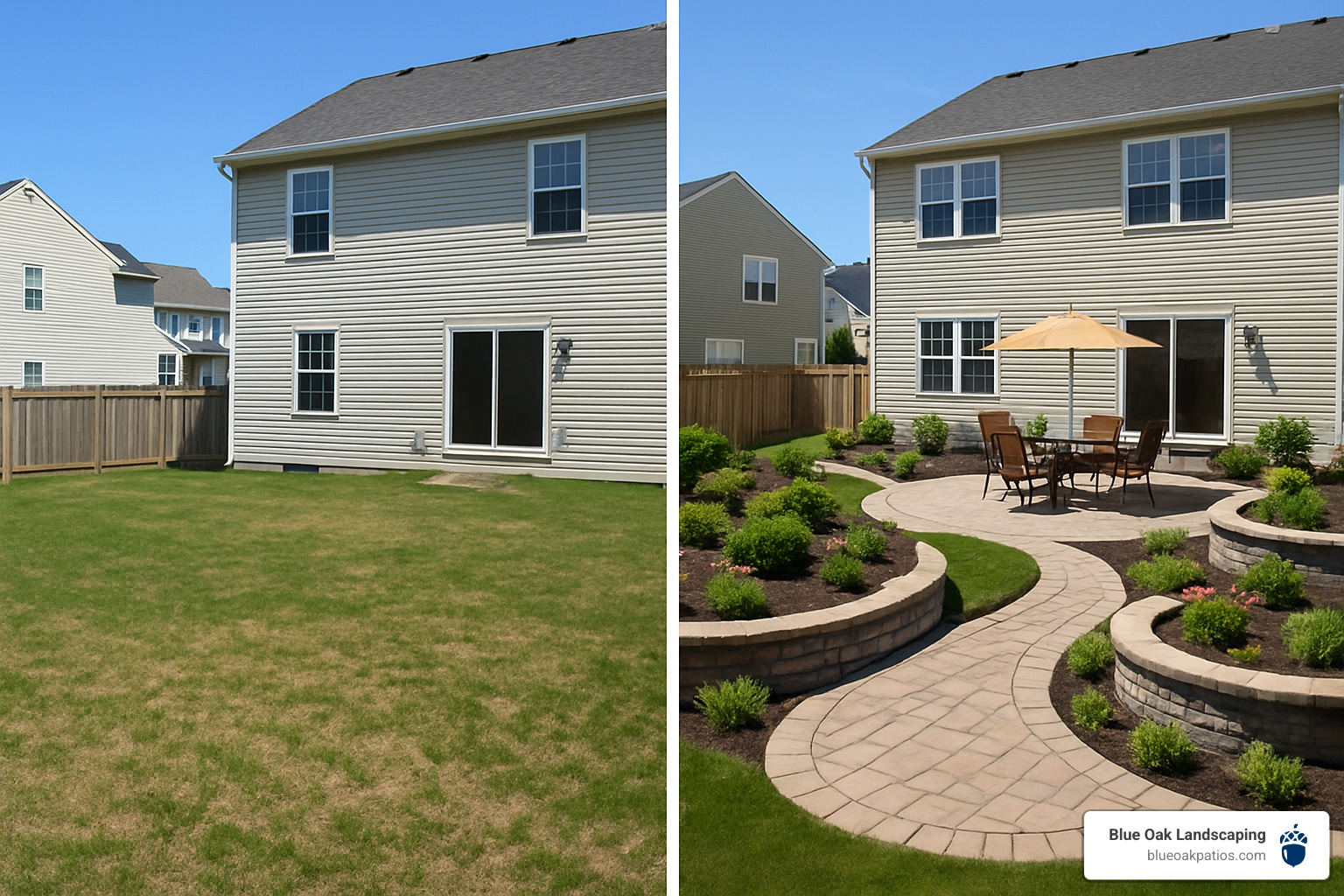
The American Society of Landscape Architects found that professional hardscaping can boost your property value by up to 15%. That’s because hard scape features genuinely improve how your property functions. They create usable outdoor rooms, improve drainage, and boost curb appeal in ways that last for decades.
The secret to great outdoor design lies in balancing hard and soft elements. Too much hardscape and your yard feels like a parking lot. Too little structure and it looks like an overgrown jungle. The sweet spot is when your hard scape provides the bones while your plants add the personality that changes with the seasons.
For more detailed guidance on achieving this balance, check out this helpful resource on Hardscaping Basics.
Hard Scape Glossary & First Use (1972)
The term “hard scape” didn’t exist until 1972. Before then, landscape professionals just called everything “landscaping.” But as the industry evolved beyond simple grass and flower beds, they needed a way to distinguish between the permanent structures and the living plants. Merriam-Webster officially recognized the term, and it stuck.
Understanding the terminology helps when you’re planning your project. Hardscape refers to all those non-living elements – your patios, walkways, and retaining walls. Softscape covers the living stuff – plants, trees, and grass. Permeable surfaces are game-changers for managing water runoff, letting rainwater soak through instead of running off into storm drains.
Popular Hardscape Features & Materials
Creating the perfect outdoor space starts with understanding which hard scape features will best serve your lifestyle and complement your home’s architecture. After two decades of designing outdoor spaces in Hilliard, I’ve seen how the right combination of features can completely transform how families use their yards.
Patios remain the heart of most hardscape projects. These outdoor rooms become the center of family life – from morning coffee to evening gatherings around the fire pit. We typically recommend sizing patios to accommodate your largest gathering plus 20% extra space for comfortable movement.
Walkways do much more than simply connect your driveway to your front door. Thoughtfully designed pathways guide visitors through your landscape, creating anticipation and findy. Gently curved walkways feel natural and inviting while showcasing different garden areas.
Fire features have become incredibly popular here in Ohio, where we want to extend our outdoor season as long as possible. Whether you choose a casual fire pit for roasting marshmallows or an neat outdoor fireplace for sophisticated entertaining, these features create natural gathering spots.
Outdoor kitchens represent the ultimate in backyard luxury. Even a simple setup with a quality grill and prep counter dramatically expands your entertaining options. More elaborate designs might include refrigeration, sinks, and storage.
Retaining walls solve practical problems while adding visual interest. They manage slopes, prevent erosion, and create defined planting areas. Modern retaining walls can incorporate built-in seating, planters, and lighting to become beautiful focal points.
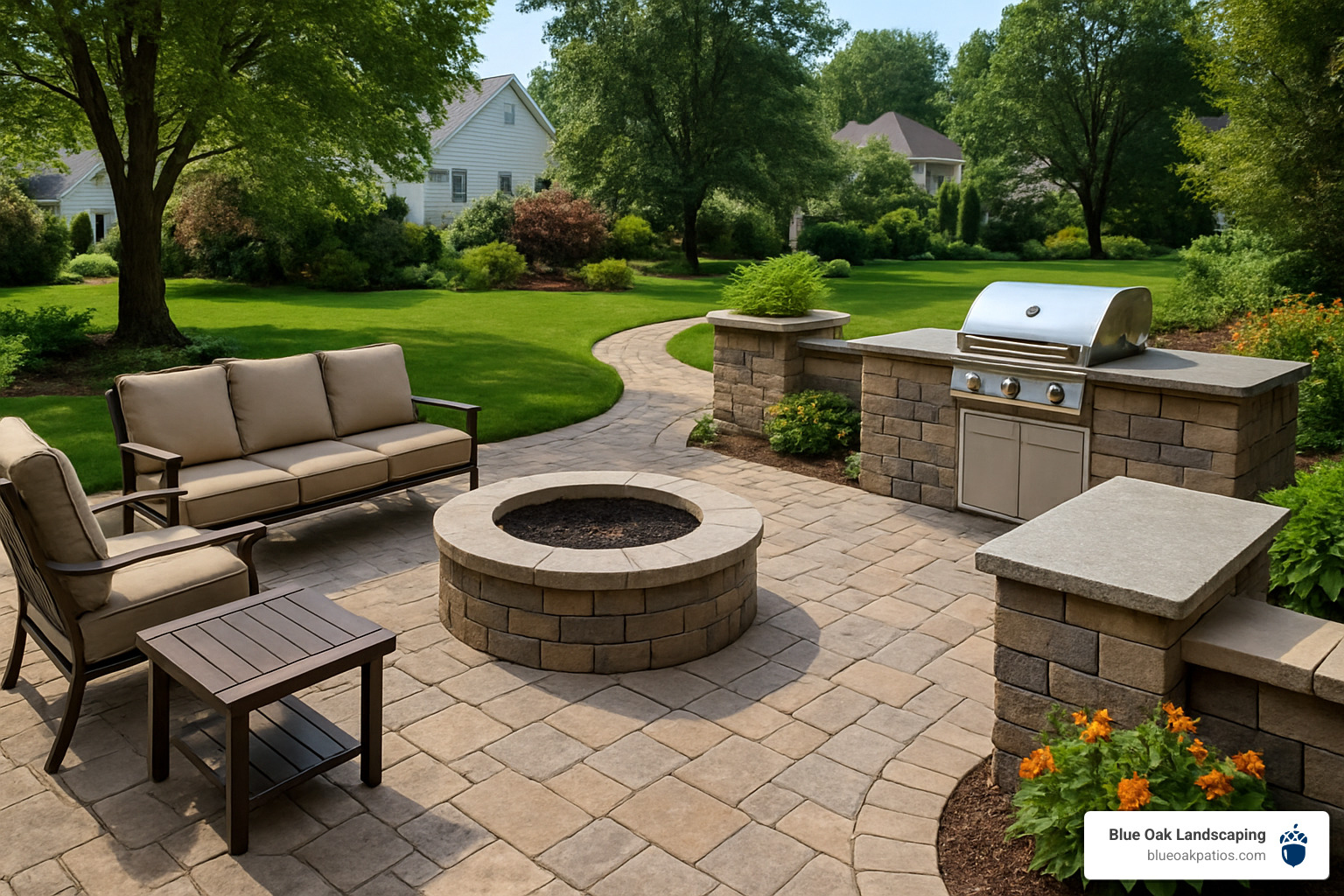
The materials you choose for your hard scape project will determine both its appearance and longevity. Living in Ohio means dealing with freeze-thaw cycles, heavy rains, and hot summers – not every material handles these conditions equally well.
Concrete pavers offer the perfect balance of durability, design flexibility, and value. Modern manufacturing techniques create pavers that beautifully mimic natural stone while providing superior strength and consistent sizing.
Permeable pavers solve both aesthetic and environmental challenges. These specially engineered units allow rainwater to pass through the surface and into the ground below, reducing runoff and helping prevent flooding.
Bluestone pavers bring classic elegance with their distinctive blue-gray coloring and natural texture. This dense stone ages beautifully and works well in both formal and casual settings.
Flagstone creates those organic, naturalistic designs that look like they’ve been part of the landscape forever. Each piece is unique, allowing us to create truly one-of-a-kind patios and walkways.
Clay brick offers timeless appeal that works particularly well with traditional home styles. Quality clay brick develops an attractive patina over time while providing excellent traction even in wet conditions.
Porcelain tile represents the newest innovation in outdoor surfaces. When properly installed over concrete bases, these tiles offer incredible design possibilities with realistic wood, stone, and fabric looks that resist fading, staining, and weather damage.
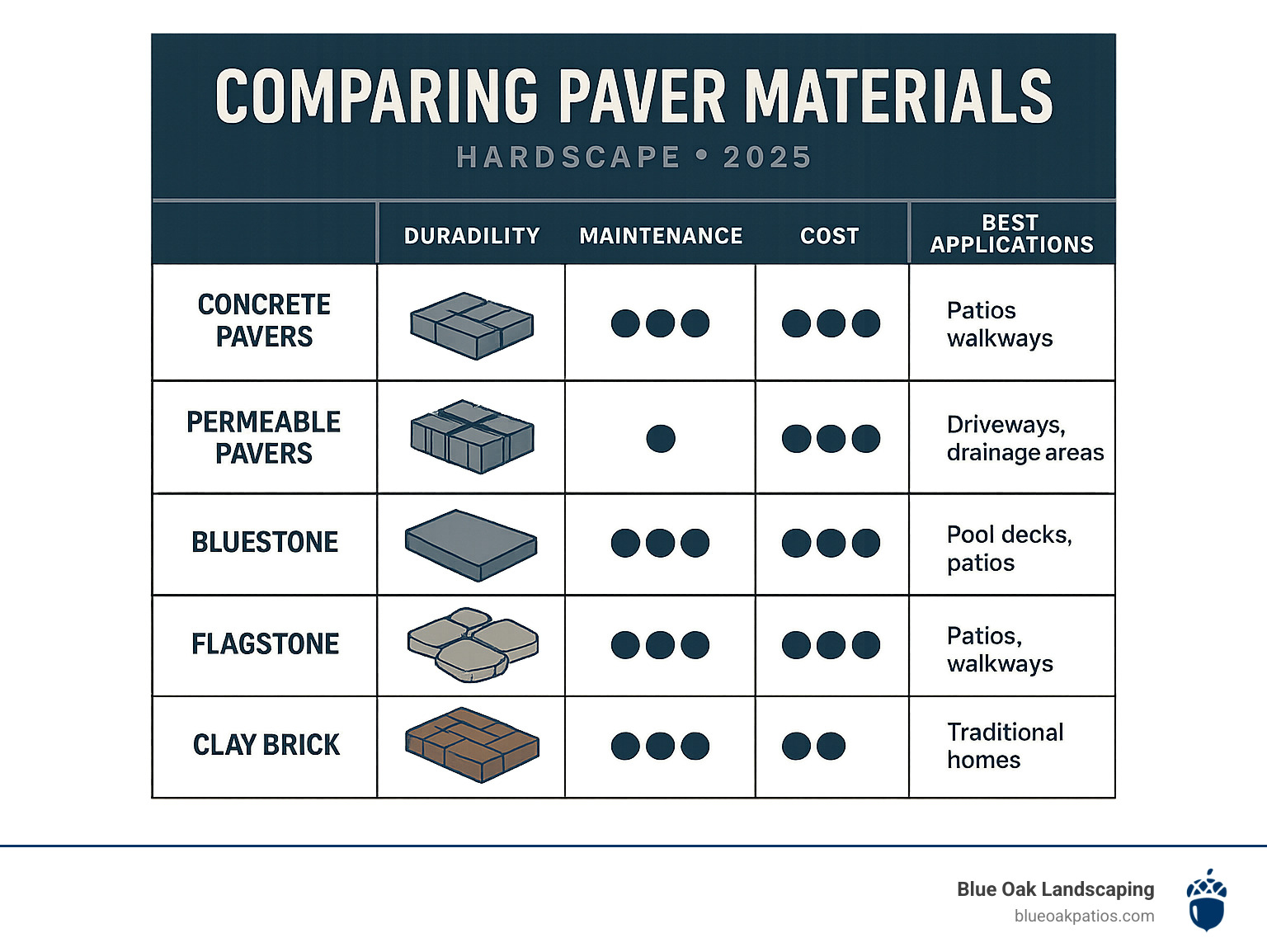
One thing we never recommend is painting or staining pavers – these treatments typically fail within a few years and create ongoing maintenance headaches. Quality materials look better and last longer when allowed to age naturally.
Planning Your Hardscape Project: From Vision to Blueprint
Successful hard scape projects begin with thorough planning that considers your lifestyle, budget, property characteristics, and long-term goals. According to a 2023 Houzz Landscaping Survey, 51% of homeowners who upgraded their outdoor spaces included hardscape features.
Define Your Project Goals
Start by honestly assessing how you want to use your outdoor space. Do you envision intimate family dinners or large parties? Will children be using the space for play, or do you prefer low-maintenance areas for quiet relaxation? Your answers shape everything from sizing to material selection.
Consider your home’s architectural style and existing landscape. The most successful hardscape projects complement rather than compete with your home’s design.
Climate Considerations for Ohio
Our Ohio climate presents specific challenges that smart planning can address. Freeze-thaw cycles demand materials and installation methods that accommodate ground movement. Proper base preparation becomes critical – we typically excavate to mineral soil and install 6-8 inches of compacted gravel base to prevent settling and frost heaving.
Drainage planning prevents costly problems later. Ohio’s clay soils shed water rather than absorbing it, making proper grading and drainage systems essential. We plan water flow paths before breaking ground, incorporating features like channel drains or French drains as needed.
Permitting and Regulations
Most hardscape projects in Hilliard, Bexley, and Upper Arlington require permits for structures over certain sizes or heights. Retaining walls over 4 feet, electrical work for lighting, and plumbing for outdoor kitchens typically need permits. We handle permit applications as part of our service.
Utility location is crucial before any excavation. We coordinate with OUPS (Ohio Utilities Protection Service) to mark underground lines before digging begins.
For comprehensive guidance on planning your project, visit our detailed resource on Hardscaping and Landscape Design.
Hard Scape Trends 2024
Current hard scape trends reflect growing interest in outdoor living and environmental responsibility. Mixed materials create visual interest – combining smooth concrete pavers with rough natural stone, or integrating wood elements with masonry for warmth and texture.
Eco-friendly materials and methods are becoming standard. Permeable surfaces, recycled materials, and native plant integration reflect homeowners’ environmental awareness. Smart technology integration includes LED lighting systems and automated irrigation.
Outdoor rooms concept continues evolving, with distinct zones for cooking, dining, lounging, and recreation. Modular systems allow flexibility for different seasons or occasions.
Choosing Hard Scape Materials for Your Climate
Ohio’s climate demands materials that withstand freeze-thaw cycles, temperature extremes, and seasonal moisture changes. We select materials based on several key factors:
Freeze-Thaw Resistance: Materials must handle water absorption and expansion without cracking. Dense stones like bluestone perform well, while some softer sandstones can deteriorate quickly.
Heat Resistance: Dark materials absorb significant heat, making them uncomfortable for bare feet around pools. Light-colored materials stay cooler but may show stains more readily.
Salt Tolerance: Areas treated with de-icing salt need materials that resist chemical damage. Concrete pavers and natural stone generally handle salt exposure better than some manufactured products.
Installation & Execution: DIY vs. Professional
When it comes to hard scape installation, the difference between a weekend project and a professional installation can mean the difference between a beautiful outdoor space that lasts decades and costly repairs within a few years.
The Foundation of Success: Professional Site Preparation
The most critical part of any hardscape project happens before you ever see the first paver. Professional installation begins with proper site preparation that sets the stage for everything that follows. We start by excavating down to stable mineral soil, removing all organic matter that could decompose and cause settling over time.
Base preparation requires specialized knowledge and equipment that most homeowners don’t have access to. We install 6-8 inches of compacted gravel in carefully controlled lifts, compacting each layer to 95% density using professional-grade equipment. This creates a stable foundation that won’t shift or settle, even through Ohio’s harsh freeze-thaw cycles.
Drainage engineering prevents the most expensive hardscape failures. Water is the enemy of any hardscape project, and managing it properly requires understanding soil conditions, water flow patterns, and grading techniques. We analyze your entire property to design drainage systems that protect both your new hardscape and your home’s foundation.
Professional crews bring years of experience in reading soil conditions, adjusting for unexpected challenges, and solving problems before they become costly mistakes.
The Value of Professional Warranties and Expertise
One of the biggest advantages of professional installation is the comprehensive warranty that covers both materials and workmanship. We stand behind our projects because we know they’re built to last.
Time savings often surprise homeowners who initially considered DIY. What might take an experienced DIYer several weekends to complete, our crews finish in days while maintaining exacting quality standards.
Professional installation also means proper tool usage and safety protocols. Hardscape work requires plate compactors, wet saws, excavation equipment, and lifting techniques that prevent injury. The cost of renting these tools often approaches the price difference between DIY and professional installation.
For detailed insights into our proven installation methods, explore Mastering the Art of Hardscaping: A Step-by-Step Guide to Changing Your Backyard.
When a DIY Hard Scape Makes Sense
Honestly, there are very few hardscape projects that make sense for DIY installation. Small pathways on level ground with excellent drainage might work for experienced DIYers who have access to proper tools and understand the importance of base preparation.
Simple patterns using uniform pavers can be more forgiving than complex designs that require precise cutting and fitting. If you’re considering DIY, stick to rectangular patterns and avoid curves, borders, or intricate designs.
Budget considerations often drive DIY decisions, but it’s important to calculate the true cost. Factor in tool rental, materials delivery, your time value, and the very real possibility of having to start over if things go wrong.
Why a Pro-Built Hard Scape Pays Off
Structural integrity becomes critical for any hardscape project involving elevation changes, retaining walls, or steps. We understand soil mechanics, load calculations, and building codes that ensure safe, durable construction.
Drainage engineering protects your investment and your property. Improper drainage can cause water to flow toward your home’s foundation, create standing water, or cause expensive settling and shifting.
Resale value benefits significantly from professional installation quality. Well-executed hardscape work adds substantial property value and creates selling points that attract buyers. Conversely, obvious DIY work that shows settling, poor drainage, or amateur finishing can actually detract from your home’s value.
The longevity of professional installation means you’ll enjoy your outdoor space for decades without major repairs or reconstruction. Professional installation also ensures compliance with local building codes and permit requirements.
Maintenance & Blending Hardscape with Softscape
A well-built hard scape requires surprisingly little upkeep compared to traditional landscaping, yet regular care ensures your investment continues looking great for decades.
Keeping Your Hardscape Looking Its Best
The foundation of hardscape maintenance is simple: keep it clean and address small issues before they become big problems. Weekly sweeping removes debris that could otherwise stain surfaces or block drainage channels.
Power washing once a year reveals the true beauty of your materials by removing accumulated grime and organic buildup. Spring is typically the best time for this deep cleaning.
Joint sand between pavers plays a crucial role in keeping your hardscape stable and weed-free. We install polymeric joint sand that hardens when activated with water, creating a durable barrier that resists washout and prevents weeds from taking root. An annual inspection usually reveals any areas where sand needs topping off.
Sealing isn’t always necessary, despite what some contractors might suggest. Quality concrete pavers with integral color rarely need sealing, and we never recommend painting or staining pavers since these treatments typically fail within a few years.
Creating Harmony Between Hard and Soft Elements
The magic happens when hard scape and softscape work together like dance partners – each complementing the other’s strengths. The most stunning outdoor spaces don’t just plop plants around hardscape features; they create intentional relationships between built and living elements.
Strategic plant placement can soften the edges of retaining walls, frame beautiful views, and provide privacy where needed. We often design planting beds that echo the curves of walkways or create color contrasts that make both the hardscape and plants look more vibrant.
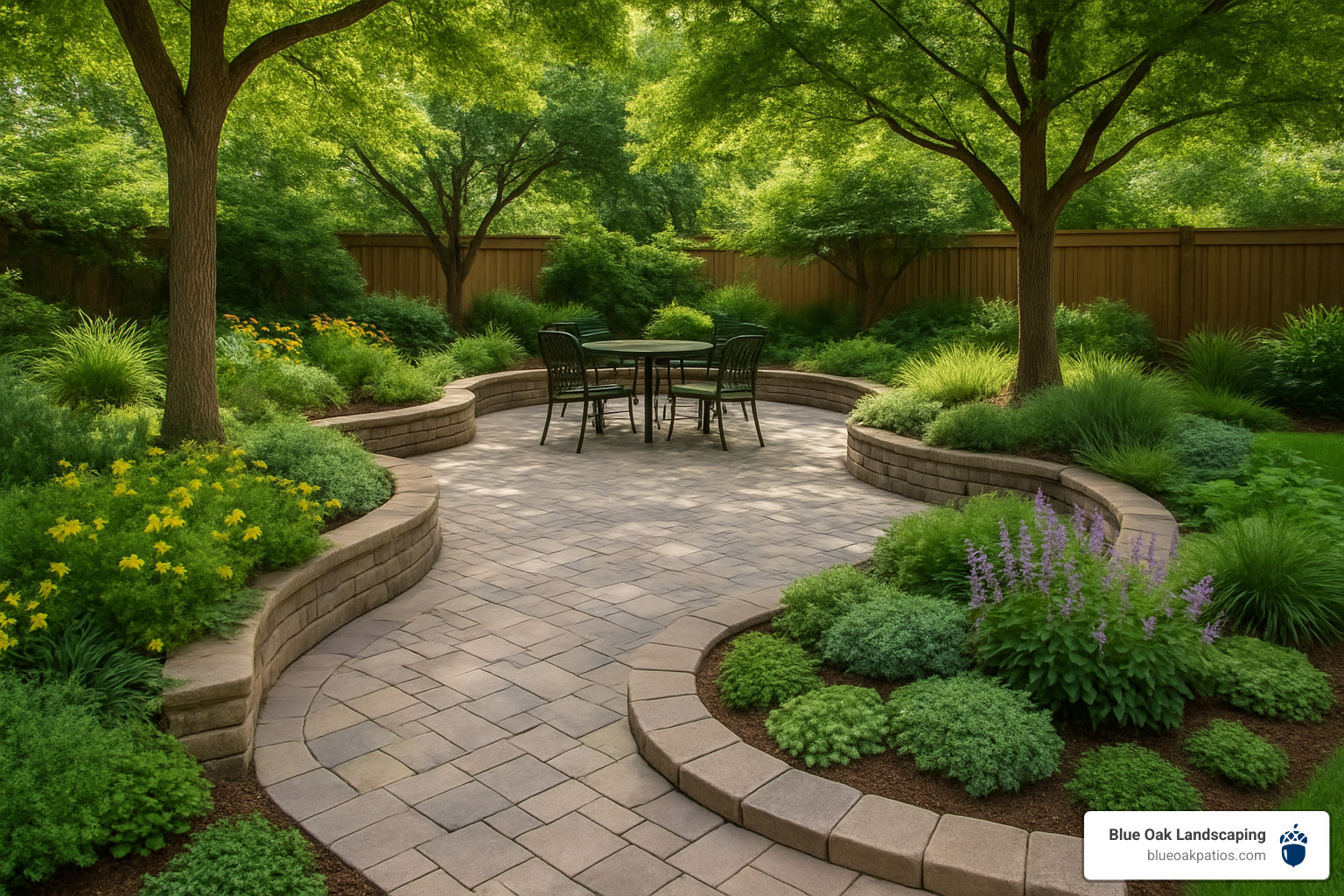
Ground covers deserve special mention for their ability to tie hardscape elements together visually. Native options like wild ginger and pachysandra create living carpets that require minimal care once established. These plants help reduce maintenance by suppressing weeds while supporting local wildlife.
Raised planters built into hardscape designs solve multiple challenges at once. They eliminate the back strain of ground-level gardening, provide excellent drainage, and protect your hardscape from soil and water damage.
For detailed guidance on installation techniques that support this integration, visit A Complete Guide to Patio and Hardscape Installation.
Annual Hard Scape Care Checklist
Seasonal maintenance doesn’t have to be overwhelming when you break it into manageable tasks. Spring cleanup involves sweeping away winter debris and giving surfaces their annual power washing. This is also the perfect time to inspect drainage systems and refill joint sand where needed.
Summer care focuses on prevention – regular sweeping to prevent stain buildup and prompt cleanup of spills before they become permanent.
Fall preparation centers on leaf removal and final deep cleaning before winter arrives. Leaves left on hardscape surfaces can create permanent stains, especially on lighter-colored materials.
Winter maintenance in Ohio means using sand rather than salt for ice control whenever possible, as salt can damage some materials over time. Remove snow promptly to prevent ice buildup.
Designing a Living Frame Around Your Hard Scape
The most successful outdoor spaces feel like natural extensions of your home rather than separate areas. This integration happens when we design planted areas that complement hardscape materials and create smooth visual transitions throughout your landscape.
Microclimate creation around hardscape features opens up exciting planting possibilities. South-facing walls create warm zones perfect for plants that might otherwise struggle in Ohio’s climate, while shaded areas under pergolas suit completely different plant palettes.
Color contrast and seasonal interest keep your outdoor space engaging year-round. We select plants that provide spring flowers, summer foliage, fall color, and winter structure, ensuring your hardscape always has an attractive living frame.
Ground covers excel at creating these seamless transitions. Native sedums spread naturally between paver joints and stone edges, while maintaining their neat appearance without constant trimming. These plants actually improve with age, developing the weathered, established look that makes outdoor spaces feel timeless.
Frequently Asked Questions about Hard Scape Projects
How much does a basic hard scape patio cost per square foot?
Hard scape patio costs depend on several key factors that can significantly impact your investment. The materials you choose make the biggest difference – concrete pavers offer excellent value and durability, while natural stone options like bluestone or flagstone typically cost more but provide unique character.
Your site conditions play a huge role in final costs too. If we can drive equipment right to your backyard, installation goes faster and costs less. But if we need to hand-carry materials through your house or around tight spaces, that adds labor time and expense.
The invisible work often represents the largest portion of your investment. Proper base preparation – excavating to stable soil, installing compacted gravel, and ensuring perfect drainage – takes time and specialized equipment. This foundation work determines whether your patio lasts decades or needs repairs in just a few years.
We always provide detailed estimates that break down every aspect of your project. You’ll see exactly where your money goes, from permits and materials to labor and cleanup. No surprise costs that can derail your budget halfway through the project.
Can permeable pavers really eliminate stormwater runoff?
Permeable pavers can indeed eliminate up to 100% of stormwater runoff compared to traditional solid surfaces. It sounds almost too good to be true, but the science is straightforward – these specially designed pavers allow water to pass through the surface into a stone reservoir below, where it slowly soaks into the soil.
The magic happens in the installation details. Permeable systems require different base materials and techniques than regular paver installation. We create a stone reservoir underneath that acts like a sponge, holding water temporarily before releasing it gradually into the ground.
Your soil conditions matter tremendously for success. Clay soils that shed water won’t work as well as sandy soils that absorb readily. We test soil permeability before recommending permeable solutions to ensure they’ll perform as expected.
Beyond eliminating runoff, permeable pavers filter pollutants from stormwater and help recharge groundwater supplies. Many communities offer incentives for installing these environmentally friendly surfaces. The maintenance is slightly different – you’ll need periodic vacuuming to keep the pores clear – but it’s typically needed only every few years.
How long should a well-built hard scape last?
A properly installed hard scape should serve your family for decades with minimal fuss. Concrete pavers typically last 25-30 years or more, while natural stone can literally last generations when properly cared for. The secret isn’t necessarily the material you choose – it’s the quality of installation underneath.
Proper base preparation makes all the difference between a patio that lasts decades and one that needs repairs within a few years. We excavate to stable mineral soil and install properly compacted gravel bases that handle Ohio’s challenging freeze-thaw cycles without shifting or settling.
Our local climate presents specific challenges that quality installation addresses. Those freeze-thaw cycles can destroy poorly installed hardscape, but proper techniques accommodate ground movement without damage. We’ve refined our methods over decades of Ohio installations.
Simple maintenance extends your hardscape life significantly. Keeping joint sand filled, removing debris promptly, and occasional power washing prevent most common problems. When we complete your project, we’ll show you exactly what to watch for and how to keep everything looking great.
Professional installation typically includes warranties covering structural issues for several years. We stand behind our work because we know proper installation techniques create hardscape that truly lasts.
Conclusion
Your outdoor space holds incredible potential for change through thoughtful hard scape design. Whether you’re dreaming of morning coffee on a peaceful patio or hosting memorable gatherings around a fire pit, the right hardscape elements can turn those visions into reality while adding substantial value to your property.
Successful hardscape projects blend artistic vision with technical expertise, considering everything from Ohio’s freeze-thaw cycles to your family’s unique lifestyle needs. This combination of form and function creates outdoor spaces that not only look stunning but perform beautifully for decades.
Quality installation makes all the difference. While the materials you see on the surface create the visual impact, it’s the invisible foundation work – proper excavation, base preparation, and drainage engineering – that determines whether your investment thrives or disappoints. Professional installation ensures that your hardscape withstands our challenging Ohio climate while maintaining its beauty year after year.
At Blue Oak Landscaping, we’ve witnessed countless changes over our 25+ years serving Hilliard, Bexley, and Upper Arlington. Each project teaches us something new about creating outdoor spaces that truly improve how families live and entertain. We understand that your hardscape isn’t just about curb appeal – it’s about creating spaces where life’s best moments unfold.
The beauty of hard scape lies in its permanence and versatility. Unlike other home improvements that may need updating in a few years, quality hardscape installation provides a foundation for outdoor living that grows more beautiful with time. These spaces adapt to your changing needs, serving as play areas for young children, entertainment spaces for teenagers, and peaceful retreats as you age.
Every successful project begins with understanding your unique vision and site conditions. For comprehensive guidance custom to your specific needs, explore our detailed resource on Finding the Right Hardscape Design for Your Outdoor Living Space. Our team is ready to help you find the incredible potential waiting in your backyard.
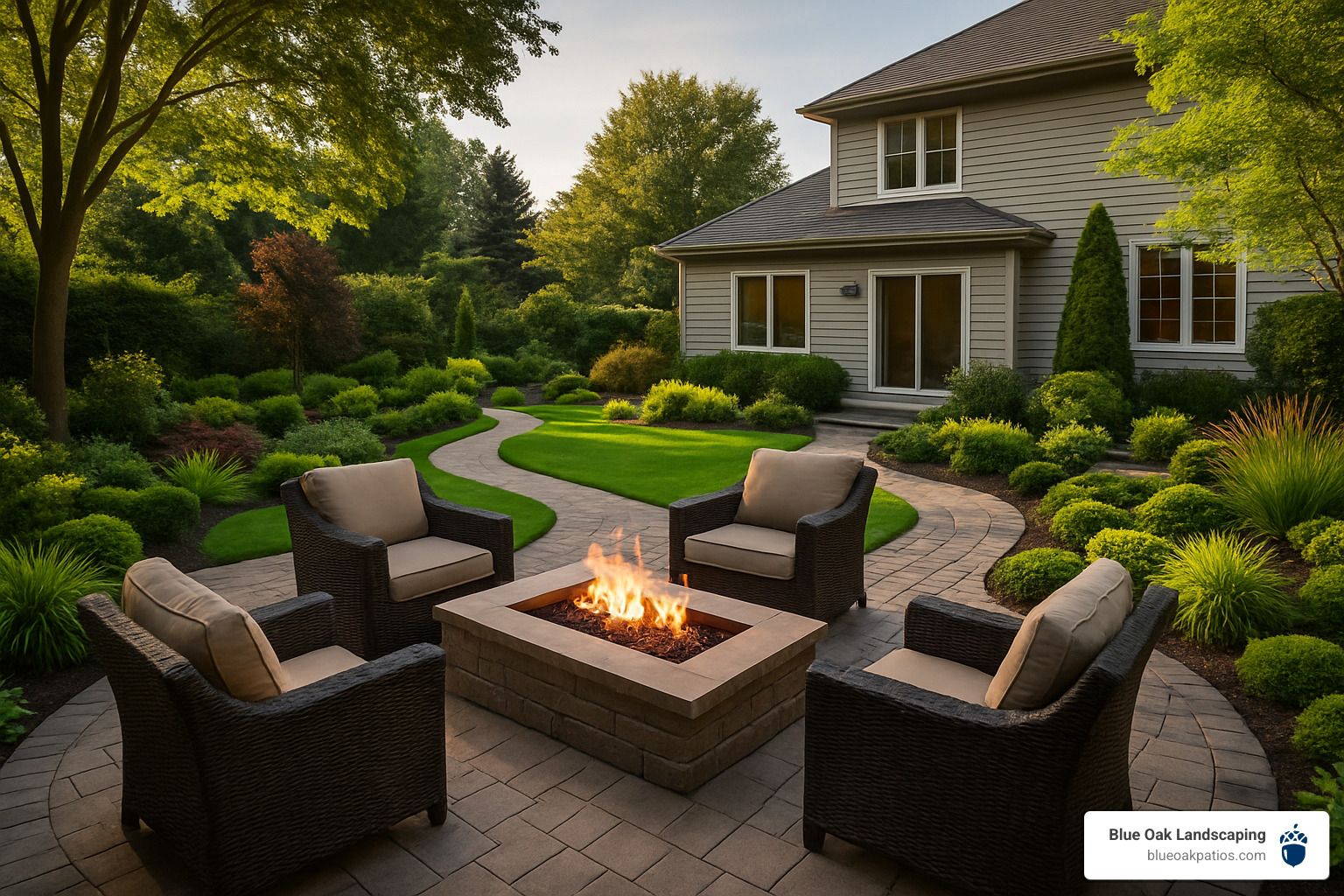
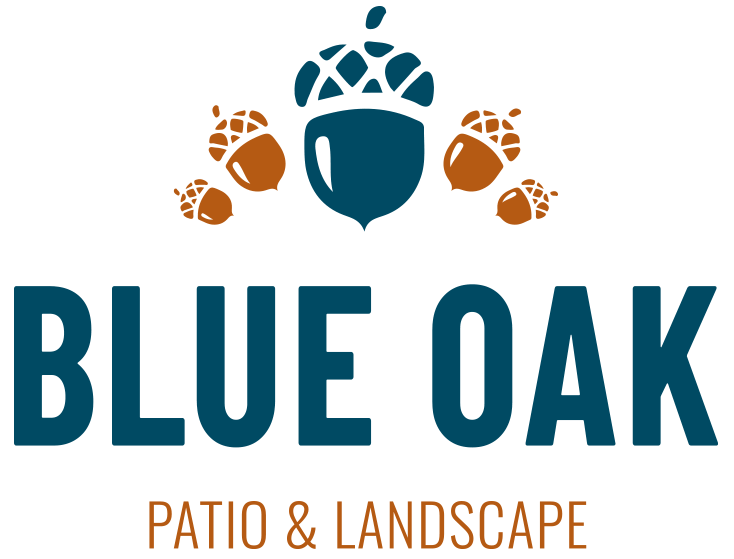
Recent Comments